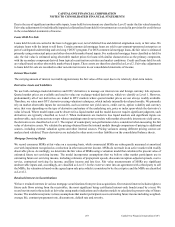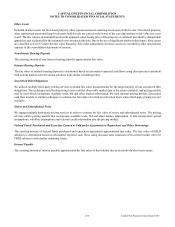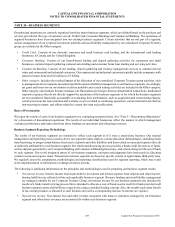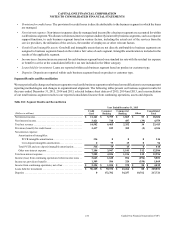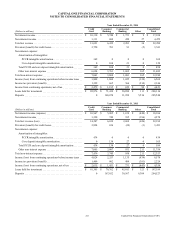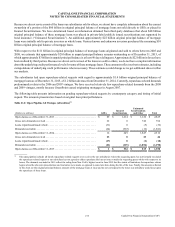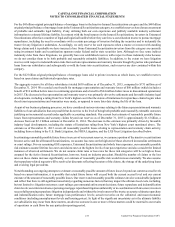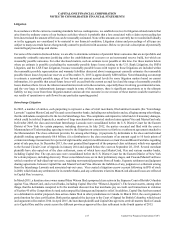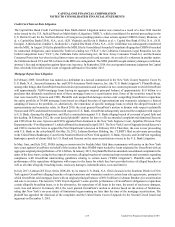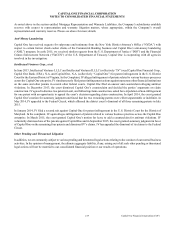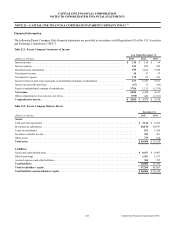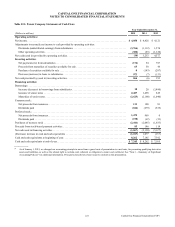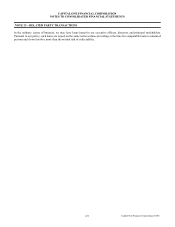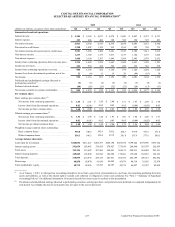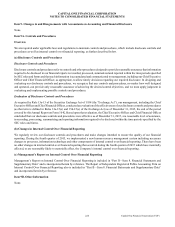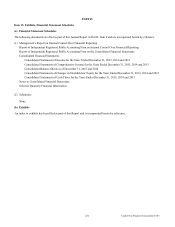Capital One 2015 Annual Report Download - page 235
Download and view the complete annual report
Please find page 235 of the 2015 Capital One annual report below. You can navigate through the pages in the report by either clicking on the pages listed below, or by using the keyword search tool below to find specific information within the annual report.CAPITAL ONE FINANCIAL CORPORATION
NOTES TO CONSOLIDATED FINANCIAL STATEMENTS
216 Capital One Financial Corporation (COF)
For the $4 billion original principal balance of mortgage loans in the Inactive Insured Securitizations category and the $48 billion
original principal balance of mortgage loans in the Uninsured Securitizations category, we establish reserves based on an assessment
of probable and estimable legal liability, if any, utilizing both our own experience and publicly available industry settlement
information to estimate lifetime liability. In contrast with the bond insurers in the Insured Securitizations, investors in Uninsured
Securitizations often face a number of legal and logistical hurdles before they can force a securitization trustee to pursue mortgage
repurchases, including the need to coordinate with a certain percentage of investors holding the securities and to indemnify the
trustee for any litigation it undertakes. Accordingly, we only reserve for such exposures when a trustee or investor with standing
brings claims and it is probable we have incurred a loss. Some Uninsured Securitization investors from this category are currently
suing investment banks and securitization sponsors under federal and/or state securities laws. Although we face some indirect
indemnity risks from these litigations, we generally have not established reserves with respect to these indemnity risks because
we do not consider them to be both probable and reasonably estimable liabilities. In addition, to the extent we have litigation
reserves with respect to indemnification risks from certain representation and warranty lawsuits brought by parties who purchased
loans from our subsidiaries and subsequently re-sold the loans into securitizations, such reserves are also contained within this
category.
For the $22 billion original principal balance of mortgage loans sold to private investors as whole loans, we establish reserves
based on open claims and historical repurchase rates.
The aggregate reserve for all three subsidiaries totaled $610 million as of December 31, 2015, compared to $731 million as of
December 31, 2014. We recorded a net benefit for mortgage representation and warranty losses of $80 million (which includes a
benefit of $16 million before taxes in continuing operations and a benefit of $64 million before taxes in discontinued operations)
in 2015. The decrease in the representation and warranty reserve was primarily driven by settlements and favorable industry legal
developments, including a ruling from New York’s highest court that the statute of limitations for repurchase claims begins when
the relevant representations and warranties were made, as opposed to some later date during the life of the loan.
As part of our business planning processes, we have considered various outcomes relating to the future representation and warranty
liabilities of our subsidiaries that are possible but do not rise to the level of being both probable and reasonably estimable outcomes
justifying an incremental accrual under applicable accounting standards. Our current best estimate of reasonably possible future
losses from representation and warranty claims beyond our reserves as of December 31, 2015 is approximately $1.6 billion, a
decrease from our $2.1 billion estimate at December 31, 2014. The decrease in this estimate was primarily driven by favorable
industry legal developments, including the statute of limitations ruling from New York’s highest court mentioned above. The
estimate as of December 31, 2015 covers all reasonably possible losses relating to representation and warranty claim activity,
including those relating to the U.S. Bank Litigation, the FHFA Litigation, and the LXS Trust Litigation described below.
In estimating reasonably possible future losses in excess of our current reserves, we assume a portion of the inactive securitizations
become active and for all Insured Securitizations, we assume loss rates on the high end of those observed in monoline settlements
or court rulings. For our remaining GSE exposures, Uninsured Securitizations and whole loan exposures, our reasonably possible
risk estimates assume lifetime loss rates and claims rates at the highest levels of our past experience and also consider the limited
instances of observed settlements. We do not assume claim rates or loss rates for these risk categories will be as high as those
assumed for the Active Insured Securitizations, however, based on industry precedent. Should the number of claims or the loss
rates on these claims increase significantly, our estimate of reasonably possible risk would increase materially. We also assume
that repurchase-related requests will be resolved at discounts reflecting the nature of the claims, the vintage of the underlying loans
and evolving legal precedents.
Notwithstanding our ongoing attempts to estimate a reasonably possible amount of future losses beyond our current accrual levels
based on current information, it is possible that actual future losses will exceed both the current accrual level and our current
estimate of the amount of reasonably possible losses. Our reserve and reasonably possible estimates involve considerable judgment
and reflect that there is still significant uncertainty regarding numerous factors that may impact the ultimate loss levels, including,
but not limited to: litigation outcomes; court rulings; governmental enforcement decisions; future repurchase and indemnification
claim levels; securitization trustees pursuing mortgage repurchase litigation unilaterally or in coordination with investors; investors
successfully pursuing repurchase litigation independently and without the involvement of the trustee as a party; ultimate repurchase
and indemnification rates; future mortgage loan performance levels; actual recoveries on the collateral; and macroeconomic
conditions (including unemployment levels and housing prices). In light of the significant uncertainty as to the ultimate liability
our subsidiaries may incur from these matters, an adverse outcome in one or more of these matters could be material to our results
of operations or cash flows for any particular reporting period.



